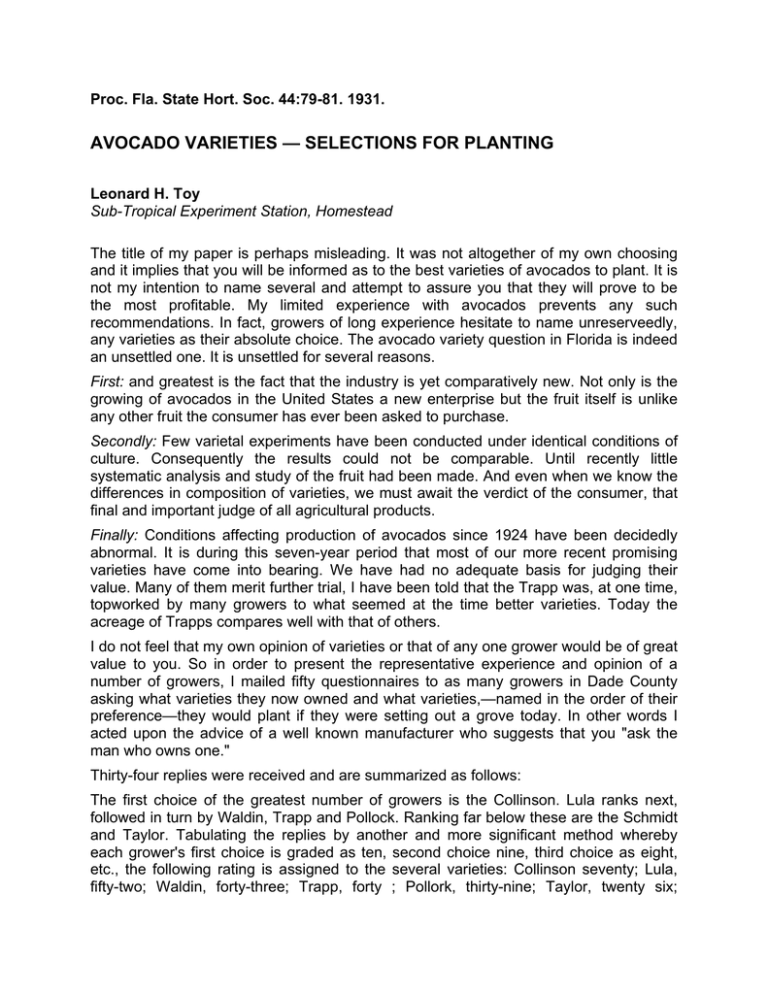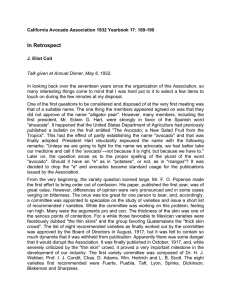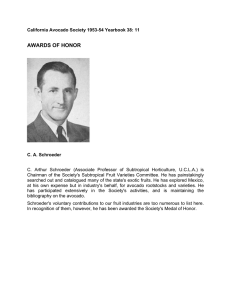AVOCADO VARIETIES — SELECTIONS FOR PLANTING
advertisement

Proc. Fla. State Hort. Soc. 44:79-81. 1931. AVOCADO VARIETIES — SELECTIONS FOR PLANTING Leonard H. Toy Sub-Tropical Experiment Station, Homestead The title of my paper is perhaps misleading. It was not altogether of my own choosing and it implies that you will be informed as to the best varieties of avocados to plant. It is not my intention to name several and attempt to assure you that they will prove to be the most profitable. My limited experience with avocados prevents any such recommendations. In fact, growers of long experience hesitate to name unreserveedly, any varieties as their absolute choice. The avocado variety question in Florida is indeed an unsettled one. It is unsettled for several reasons. First: and greatest is the fact that the industry is yet comparatively new. Not only is the growing of avocados in the United States a new enterprise but the fruit itself is unlike any other fruit the consumer has ever been asked to purchase. Secondly: Few varietal experiments have been conducted under identical conditions of culture. Consequently the results could not be comparable. Until recently little systematic analysis and study of the fruit had been made. And even when we know the differences in composition of varieties, we must await the verdict of the consumer, that final and important judge of all agricultural products. Finally: Conditions affecting production of avocados since 1924 have been decidedly abnormal. It is during this seven-year period that most of our more recent promising varieties have come into bearing. We have had no adequate basis for judging their value. Many of them merit further trial, I have been told that the Trapp was, at one time, topworked by many growers to what seemed at the time better varieties. Today the acreage of Trapps compares well with that of others. I do not feel that my own opinion of varieties or that of any one grower would be of great value to you. So in order to present the representative experience and opinion of a number of growers, I mailed fifty questionnaires to as many growers in Dade County asking what varieties they now owned and what varieties,—named in the order of their preference—they would plant if they were setting out a grove today. In other words I acted upon the advice of a well known manufacturer who suggests that you "ask the man who owns one." Thirty-four replies were received and are summarized as follows: The first choice of the greatest number of growers is the Collinson. Lula ranks next, followed in turn by Waldin, Trapp and Pollock. Ranking far below these are the Schmidt and Taylor. Tabulating the replies by another and more significant method whereby each grower's first choice is graded as ten, second choice nine, third choice as eight, etc., the following rating is assigned to the several varieties: Collinson seventy; Lula, fifty-two; Waldin, forty-three; Trapp, forty ; Pollork, thirty-nine; Taylor, twenty six; Schmidt, twenty-four. In this paper I have purposely avoided considering varieties suited to parts of Florida other than the lower east coast. My knowledge of avocado growing in those sections is even less than that of our immediate vicinity. There are growers in the audience from up the state who, I am sure, will be glad to answer any questions you may have. I shall not bore you by describing the numerous varieties grown in this section. Many of you are more familiar with them than I. I shall, however, try to picture an ideal avocado, basing my description on some experience and observation and much inquiry among growers, shippers and consumers. The ideal variety should be reasonably easy to propagate, a relatively vigorous grower, with enough foliage to protect the fruit from sunburn. Its average yield over a period of years should be greater than that of our existing varieties. It should have a low, spreading habit of growth in order to shade the ground earlier, to increase the wind resistance, and to facilitate spraying and picking operations. It must be relatively hardy, and resistant to disease and the attacks of insect pests. The fruit should have a fairly smooth skin, a regular shape, and preferably a glossy green color. The best size for market purposes is from twelve to sixteen ounces, although larger sizes are sometimes in demand for special trade. The flesh of the fruit should be free from fibre and should possess a good flavor. The seed should be small in proportion to the size of the fruit. As to the oil content I hardly know what to say. Most consumers who have been introduced to the Mexican and Guatemalan varieties with their normally high content of oil like them very well indeed. On the other hand many prefer the West Indians with their comparatively low content of oil. Satisfactory carrying or shipping quality is another very important requisite. The season of maturity of an ideal variety is difficult to state because of possible future developments in avocado producing regions. The immediate outlook leads me to name two seasons, either of which would permit the grower to ship his fruit when there is a relative scarcity of avocados on the market. The first extends from June first, to August first, preferably the month of June. The second is the period from the middle of November to February first. There is and probably will always be a profitable but limited local market for avocados maturing later than February first. In discussing the season of maturity I can do no better than refer you to the following paragraph from a paper delivered before the Florida Avocado Association in 1923 by the late William J. Krome. "The season of maturity may almost determine the value of an entire crop of avocados. Under present conditions fruit maturing during June, July and the early part of August will command prices that will show a good profit to the grower. From the middle of August to the middle of October, Cuban seedlings, Florida seedlings, and some of the fruit from our budded varieties are all thrown onto markets which are still well supplied with northern grown produce, and until we have the avocado better introduced and more systematically distributed this two months period will be one of little profit to the grower. Beginning about the middle of October or first of November avocado prices usually begin to improve and from then on until the middle or end of March are generally quite satisfactory. These conditions will undoubtedly change as production increases but at present the avocado planter will do well to make his selection of varieties such that there will be least conflict between their maturing fruit and that of other producing sections, or the bulk of production in our own state." These words, spoken eight years ago are just as true today. We shall never find the avocado variety which is perfect in every detail. We can continue trying to improve on those we have at present. The two leading varieties indicated by the above mentioned questionnaire are both hybrids of local origin, which suggests that for future improvement we have been shown the way and would do well to follow.



